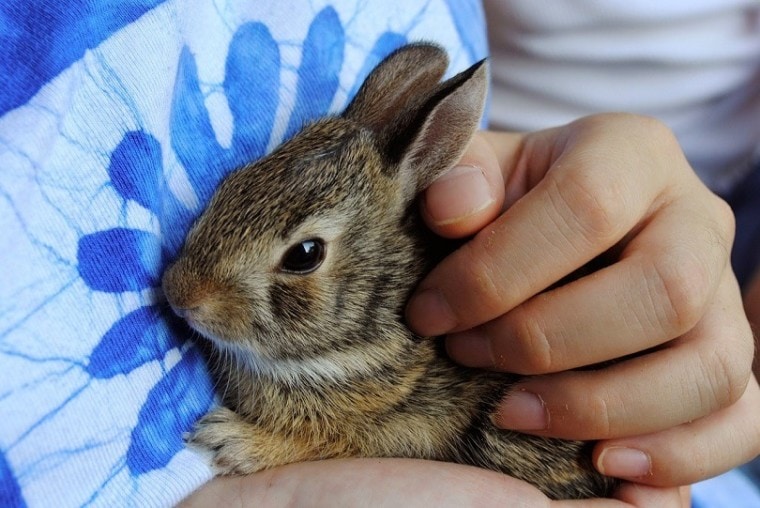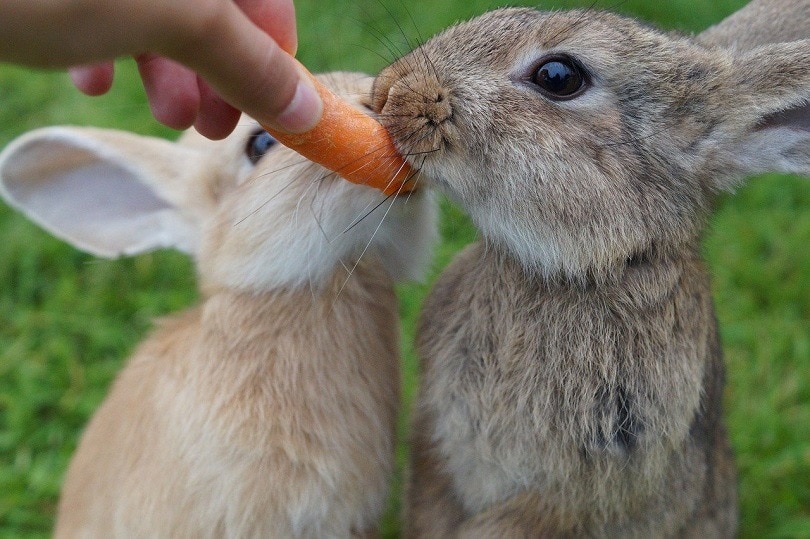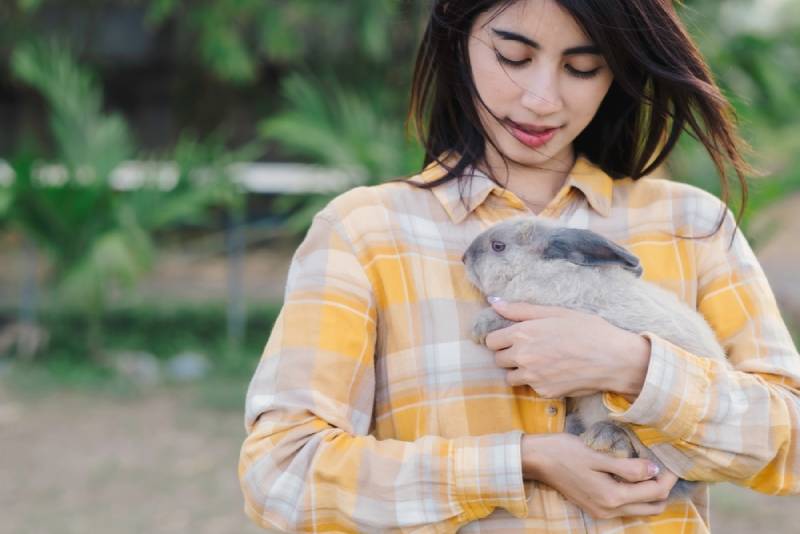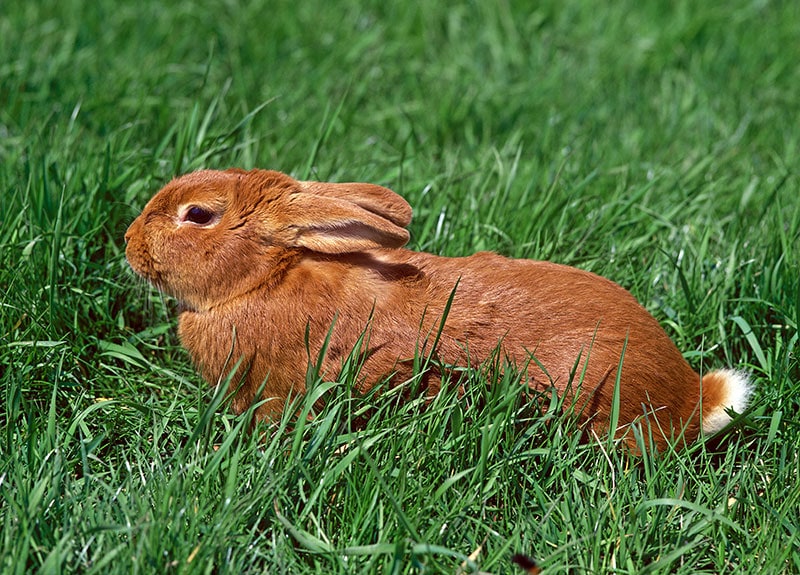
Rabbits make wonderful pets, but getting them used to being handled regularly can take time and patience. Your kids may be desperate to play with their new friend, but rushing this process can leave your rabbit feeling threatened.
Many domestic rabbits can show signs of fear when they’re lifted up. About 60% of rabbit owners say that their rabbit struggles and can even become aggressive when they try to pick them up. So, what can we do to improve the bond between us and our pet rabbits?
The good news is that there are plenty of options! We’ve rounded up our favorite, science-backed ways to bond with your rabbit.
We’ve also included details of one technique that should always be avoided.
The 12 Ways for How to Bond With Your Rabbit
1. Give Treats to Your Rabbit
The scientific term for this is “classical conditioning” but really, all you’re doing is getting your rabbit to associate you with good things — namely, yummy treats! It’s a basic strategy on how to bond with and get a bunny to like you. This is one of the first ways to bond with your rabbit, so don’t try to pick them up until you’ve got this one nailed.
All you need to do is spend time quietly hanging out with your rabbit — with them in their cage to start with, if that’s easier. As they come near you, give them a small treat. You can experiment with different treats, finding out which ones your rabbit loves best. As your rabbit associates you and your family with treats, they will naturally start to approach you with more confidence. After a while, you can slowly decrease the number of treats you give them, but don’t stop with the treats altogether!

2. Be Present & Patient
Putting pressure on your rabbit to spend time with you will likely result in the opposite reaction. Instead, put aside the time to simply hang out with your rabbit. Don’t go in there expecting to pick them up or even accomplish anything specific. Just sit down in an enclosed, bunny-safe room and allow your rabbit to explore. They’re curious creatures, so they will soon hop over to investigate you! Drop a few treats on the floor when they do so, to reinforce the fact that being near you is a good thing!
3. Stay Calm & Quiet
Rabbits are, by their very nature, quick to startle. So, loud noises and erratic movements can cause them to become worried. Remember to moderate your tone of voice and avoid sudden movements when hanging out with your rabbit.
If your kids are handling your rabbit too, then make sure they know the ground rules of how to behave. A rabbit that’s cornered by an overenthusiastic and inexperienced junior handler may well panic or become aggressive if they feel trapped.

4. Don’t Hold Your Rabbit (All the Time)
We know that it can be tempting to pick your bunny up and give them a good cuddle, but actually, many rabbits don’t initially enjoy being held! There are plenty of other ways to bond and interact with your rabbit, though. You can stroke them, cuddle them as they sit next to you, or lay down on the floor and watch them observe you from a different angle.
We’re not suggesting to never hold or pick up your rabbit, but take the time to accustom your rabbit to being held and hang out with them in other ways while you’re working on getting them used to being picked up.
If you do pick up your rabbit, make sure you hold them correctly, using one of these methods:
Never, ever pick your rabbit up by the scruff of their neck.
5. Clicker-train Your Rabbit
Did you know that you can clicker-train your rabbit? Giving your rabbit the choice of getting picked up can be a great way to solve some of the issues that rabbit owners encounter when trying to handle their fluffy friends.
You’ll need a clicker or to know how to make a “cluck” noise with your tongue to indicate to your rabbit that they are carrying out the correct behavior.
Holding out your hands and clicking when your rabbit comes between them is the first stage. When your rabbit is on the floor and between your hands, click and reward them with a treat.
The next stage is to apply a short amount of gentle pressure to the sides of your rabbit with your hands, but allowing them to remain on the floor where they feel safe. Squeeze, click, and reward.
Once your rabbit is confident with this stage, you can lift your rabbit a little way off the floor for a short amount of time. Remember to click and reward.
Some rabbits can also be trained to jump into your lap. Clicker training gives your rabbit a choice, and it’s okay if they decide that they don’t want to be picked up at that point; you can try again later!
You can watch a video of this training sequence here.
6. Be Consistent
As with many other pets, and people, consistent behavior will help your rabbit feel more comfortable and confident in your company. If you only handle your rabbit once a week and then expect them to be happy being picked up, then you may be disappointed to find that your rabbit has other ideas!
Try to spend time with your bunny every single day, whether that’s a quick brush and a stroke or a longer session training them to get used to being picked up. The more familiar you are to your rabbit, the happier and more trusting around you they will become.
Rabbits thrive on routine, so keeping to the same feeding and cleaning schedule can help them feel more secure, and this leads to them feeling more confident when you’re handling them.
7. Find Out Your Rabbit’s Personality
Taking the time to work out your rabbit’s personality can help you decide the best way to bond with and handle them. Some rabbits will quickly become outgoing and cheeky, while others may be shy and nervous. Some will even be scared and potentially aggressive.
Once you’ve worked out the basis of your rabbit’s personality, you can tailor your interactions to suit them. A confident and outgoing rabbit may quickly learn how to be picked up, while a shy rabbit may need longer to become comfortable with this, and even then, they may prefer being stroked while they’re safely on the ground instead!

8. Play With Your Rabbit
Rabbits are sociable and most of them love to play! Invest in chew toys for your bunny, and spend time simply hanging out with them as they discover these tasty treats. An added benefit is that toys that require gnawing will also help keep your rabbit’s teeth in great condition.
Treat dispenser balls are also great fun for your rabbit to play with, and you can have fun watching to see how quickly they figure out how to access the treats inside!
9. Get Your Rabbit Spayed or Neutered
As rabbits reach maturity, they can start to become aggressive and harder to handle. At this point, scheduling an appointment to have your rabbit spayed or neutered can solve many of these issues.

10. Give Your Rabbit Space
One of the best ways to bond with your rabbit is to give them the space to be, well, a rabbit! Rabbits kept in small enclosures without much enrichment will soon become bored and stressed. It’s important to make sure your rabbit has a large hutch, as well as an outdoor enclosure to enjoy if possible.
Keep your rabbit’s hutch as a “safe space” that is theirs and theirs alone. Allow your rabbit out of their hutch for exercise, training, and bonding sessions. You might have a ramp that they can use to run back into their hutch, and if they do so, consider this a clear signal that your session is over!
11. Learn to Recognize Fear Behaviors in Rabbits
Being able to identify when your rabbit is exhibiting fearful body language will help you know when to allow them a little space. If your rabbit seems happy and confident, they may be up for a training session. If they’re fearful or upset by something, it’s probably best to allow them quiet time in their hutch.
If your rabbit is jumping around, it means they’re happy and feeling confident. Some rabbits will also sprawl, shake their ears, or sit in a “loaf” position when they’re feeling comfortable and confident.
On the other hand, if they’re flattened to the ground, with widened eyes and tense muscles, then these are clear signs of fear.

12. Choose a Baby Rabbit That’s Been Handled Already
Scientific studies have shown that regular handling of baby rabbits while they’re still nursing can help reduce their fear response. This means as they grow up, they should be easier to handle. The effects of being handled early were found to last into adulthood.
Experienced rabbit breeders will usually handle their baby bunnies, so make sure to ask any breeder with baby rabbits if they’ve been regularly handled.

One Way NOT to Bond With Your Rabbit: Trancing or Tonic Immobility
You may see some sites advocating placing your rabbit into a trance by holding them on their back. The scientific term for this state is “tonic immobility.” Some rabbit owners suggest using this technique to make it easier to groom your rabbit and trim their nails. But professional organizations, including the Rabbit Welfare Association & Fund, advise against ever using this method: “Trancing or ‘hypnotizing’ your rabbit is not a fun trick. Rabbits are a prey species and are in fact terrified and playing dead. They can be groomed without resorting to this.”
There have also been scientific studies into this technique, mentioning that tonic immobility used to be considered a way to show affection or increase bonding between rabbits and their owners. Now we know that’s definitely not the case.
Rabbits placed into tonic immobility states display physiological signs of stress, including elevated heart and respiration rates. They also demonstrated fearful behaviors, including widened eyes, flattened ears, and increased muscle tension.
Vets may sometimes use tonic immobility as a way to examine your rabbit rather than placing them under anesthesia, but owners should never attempt it on their own.
Related Reads:
- Do Rabbits Like to Cuddle? Signs of Affection
- How Do I Know If My Rabbit Likes Me? 7 Signs & Bonding Tips
Featured Image Credit: Incygneia, Pixabay









